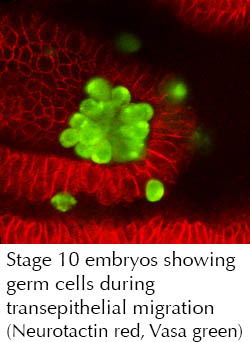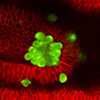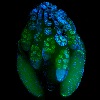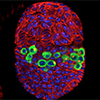 PGCs form at the posterior pole of the Drosophila embryo and are carried inside the embryo during gastrulation in juxtaposition to the posterior midgut. Subsequently, PGCs migrate actively through the midgut epithelium and navigate along the midgut toward the mesoderm, where they associate with somatic gonadal precursors to form the embryonic gonad. At least three signaling pathways regulate germ cell migration: a) The G protein coupled receptor Tre1 controls transepithelial migration through the posterior midgut. b) Wunen and Wunen 2, two lipid phosphate phosphatase, affect germ cell repulsion and survival. c) The isoprenylation via the HMGCoA reductase pathway regulates the production of a germ cell attractant. Complementary to genetic and biochemical studies we are using high-resolution live imaging to develop a dynamic, cellular view of germ cell chemoattraction and repulsion and have developed in vitro migration assays to identify the molecules involved in germ cell chemotaxis and survival. Recent studies have used single PGC tracing to measure cell-to-cell variability in order to assess how qualitative and quantitative differences between cells influence migratory success in an in vivo setting.
PGCs form at the posterior pole of the Drosophila embryo and are carried inside the embryo during gastrulation in juxtaposition to the posterior midgut. Subsequently, PGCs migrate actively through the midgut epithelium and navigate along the midgut toward the mesoderm, where they associate with somatic gonadal precursors to form the embryonic gonad. At least three signaling pathways regulate germ cell migration: a) The G protein coupled receptor Tre1 controls transepithelial migration through the posterior midgut. b) Wunen and Wunen 2, two lipid phosphate phosphatase, affect germ cell repulsion and survival. c) The isoprenylation via the HMGCoA reductase pathway regulates the production of a germ cell attractant. Complementary to genetic and biochemical studies we are using high-resolution live imaging to develop a dynamic, cellular view of germ cell chemoattraction and repulsion and have developed in vitro migration assays to identify the molecules involved in germ cell chemotaxis and survival. Recent studies have used single PGC tracing to measure cell-to-cell variability in order to assess how qualitative and quantitative differences between cells influence migratory success in an in vivo setting.
Research Areas:
|
|
|
|
|
|







